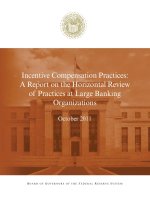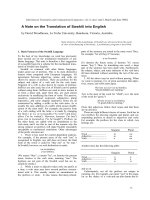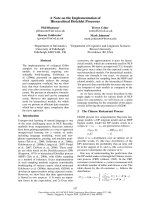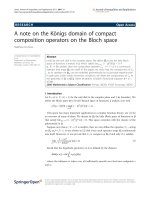A note on the Non negativity of continuous time ARMA and GARCH processes
Bạn đang xem bản rút gọn của tài liệu. Xem và tải ngay bản đầy đủ của tài liệu tại đây (114.05 KB, 15 trang )
A Note on the Non-negativity of
Continuous-time ARMA and GARCH
Processes
HENGHSIU TSAI
Institute of Statistical Science, Academia Sinica, Taipei,
Taiwan 115, R.O.C.
K. S. CHAN
Department of Statistics & Actuarial Science,
University of Iowa, Iowa City, IA 52242, U.S.A.
January 18, 2006
Abstract
A general approach for modeling the volatility process in continuous-time
is based on the convolution of a kernel with a non-decreasing L´evy process,
which is non-negative if the kernel is non-negative. Within the framework
1
of Continuous-time Auto-Regressive Moving-Average (CARMA) processes,
we derive a sufficient condition for the kernel to be non-negative, based on
which we propose a numerical method for checking the non-negativity of a
kernel function. We discuss how to adapt this approach to solving a similar
problem with the second approach to modeling volatility via the COntinuoustime Generalized Auto-Regressive Conditional Heteroscedastic (COGARCH)
processes.
Some key words: DIRECT; global optimization; kernel; L´evy process; Volatility.
1
Introduction
Prompted by the need for analyzing financial time series, there has been
recently much work on developing models suitable for analyzing the volatility of a continuous-time process, see Andersen & Lund (1997), Comte &
Renault (1998), Barndorff-Nielsen & Shephard (2001), Brockwell (2004),
Kl¨
uppelberg et al. (2004), Brockwell & Marquardt (2005) and Brockwell
et al. (2006). There are, at least, two approaches to modeling a continuoustime volatility process. In the first approach, the volatility process is modeled as some continuous-time Auto-Regressive Moving-Average (CARMA)
process driven by a L´evy process, e.g. a compound Poisson process; see
Barndorff-Nielsen & Shephard (2001), Brockwell (2004) and Brockwell &
Marquardt (2005). Conditional on the volatility process, the observed process (after suitable transformation) is modeled as some diffusion process.
Thus, there is no direct feedback to the volatility process from the ob-
2
served process. For financial applications of the non-negative L´evy-driven
CARMA processes, see Roberts et al. (2004), or a working paper (available at by Todorov
& Tauchen (2005). The second approach attempts to directly model the
volatility process in terms of the current and past values of the observed process, i.e. to lift the discrete-time Generalized Auto-Regressive Conditional
Heteroscedastic (GARCH) model to the continuous-time setting. This leads
to the development of the COntinuous-time Generalized Auto-Regressive
Conditional Heteroscedastic (COGARCH) processes proposed by Kl¨
uppelberg
et al. (2004) and Brockwell et al. (2006).
For volatility modeling, the continuous-time process must be non-negative.
A stationary L´evy-driven CARMA process can be shown to be the convolution of a kernel function with a L´evy-driving process, which is non-negative
if the kernel is non-negative and the L´evy-driving process is a non-decreasing
process. Tsai & Chan (2005) showed that the kernel of a CARMA process
is non-negative if and only if its Laplace transform is completely monotone.
Based on this characterization, Tsai & Chan (2005) gave some more readily
verifiable necessary and sufficient conditions for the kernel to be non-negative
for some lower order CARMA processes. However, analogous results are lacking for higher order cases. Here, we obtain some new sufficient (necessary)
conditions for the non-negativity of the kernel of a CARMA process, based
on which we propose a numerical method for verifying the non-negativity of
the kernel of a general CARMA process.
The rest of this paper is organized as follows. In § 2, we briefly review the
L´evy-driven CARMA processes. The main result is stated in § 3. We illus-
3
trate our numerical approach for verifying the non-negativity of a CARMA
process in § 4. The COGARCH processes are reviewed in § 5. We point out
that the approach outlined in § 3 can be adapted to solve the non-negativity
problem for a COGARCH process. The proof of the main result is deferred
to the appendix.
2
CARMA Processes
We now recall the L´evy-driven CARMA(p, q) process introduced by Brockwell (2000, 2001, and 2004). The L´evy process is defined in terms of infinitely
divisible distributions. Let φ(u) be the characteristic function of a distribution. We say that the distribution is infinitely divisible if, for every positive
integer n, φ(u) is the nth power of some characteristic function. Let R be a
set of real numbers. For every infinitely divisible distribution, we can define
a stochastic process {Xt , t ∈ R}, called a L´evy process, such that X0 ≡ 0,
and it has independent and stationary increments with (φ(u))t as the characteristic function of Xt+s − Xs , for any s ∈ R and t ≥ 0. For more information
on L´evy processes, see Protter (1991), Bertoin (1996), Sato (1999), and Applebaum (2004). Heuristically, a L´evy-driven CARMA(p, q) process {Yt } is
defined as the solution of a p-th order stochastic differential equation with
suitable initial condition, and driven by a L´evy process and its derivatives
up to and including order 0 ≤ q < p. Specifically, for t ∈ R,
(p)
Yt
(p−1)
− αp Yt
(1)
(2)
(q+1)
− · · · − α1 Yt − α0 = σ{Lt + β1 Lt + · · · + βq Lt
}, (1)
where {Lt , t ∈ R} is a L´evy process with L0 ≡ 0 and EL21 = 1; the superscript
(j)
(j−1)
denotes j-fold differentiation with respect to t, i.e. dYt
4
=
(j)
Yt dt, j = 1, ..., p − 1. Note that the derivatives may not be well-defined
in the usual sense; here their use merely serves as a shorthand for a vector
integral equation to be defined below. We assume that σ > 0, α1 = 0, and
βq = 0.
Equation (1) can be equivalently cast in terms of the observation and
state equations (see Brockwell, 2001):
′
Y t = β Xt ,
t ∈ R,
dXt = (AXt + α0 δ)dt + σδdLt ,
where the superscript prime denotes taking the transpose,
(0)
0 1 0 ··· 0
Xt
(1)
0 0 1 ··· 0
Xt
..
..
.. . .
..
..
A= .
. . , Xt =
, δ =
.
.
.
(p−2)
0 0 0 ··· 1
Xt
(p−1)
α1 α2 α3 · · · αp
Xt
(2)
0
0
..
.
0
1
1
β1
.
, β = ..
βp−2
βp−1
βj = 0 for j > q. The stationary mean of Yt , if it exists, can be shown
to equal −α0 /α1 , see Tsai & Chan (2005). The stationary mean must be
non-negative for the process to model conditional variances; for simplicity,
we henceforth assume that α0 = 0.
Provided all the eigenvalues of A have negative real parts, the process
{Xt } defined by
t
Xt = σ
exp{A(t − u)}δdLu
−∞
is the strictly stationary solution of (2) for t ∈ (−∞, ∞) with the corresponding CARMA process given by
∞
Yt = σ
g(t − u)dLu ,
−∞
5
−∞ < t < ∞,
(3)
,
′
where g(t) = β exp(At)δI[0,∞) (t). Henceforth in this paper, let λ1 , · · · , λp be
the roots of α(z) = 0. Without loss of generality, assume Re(λp ) ≤ · · · ≤
Re(λ2 ) ≤ Re(λ1 ) < 0, where Re(λi ) denotes the real part of λi . In the case
when λ1 , ..., λp are distinct and Re(λj ) < 0, for j = 1, ..., p, Brockwell &
Marquardt (2005) showed that, for u ≥ 0,
p
g(u) =
r=1
β(λr )
exp(λr u),
α(1) (λr )
(4)
where α(1) denotes its first derivative, α(z) = z p − αp z p−1 − · · · − α1 and
β(z) = 1 + β1 z + β2 z 2 + · · · + βq z q . Equation (4) implies that the kernel
function is Lipschitz continuous. Recall that the characteristic equation of
A, i.e. det(A−zI) = 0, equals α(z) = 0. We assume that all roots of α(z) = 0
and those of β(z) = 0 have negative real parts, and the two equations have
no common roots. The condition on the roots of α(z) = 0 is necessary for the
stationarity of the process whereas that on β(z) = 0 is for the process to be
of minimum phase and is akin to the invertibility condition for discrete-time
processes. We claim that if the CARMA(p, q) process {Yt } is stationary, then
αj < 0, for j = 1, ..., p. The cases of p = 1 and p = 2 can be checked by
algebra. For higher order cases, we note that the characteristic polynomial
zp − αp z p−1 − · · · − α1 can be factorized into products of real polynomials
of degree not greater than two, all of which have positive coefficients based
on the arguments presented for orders one and two. Similarly, it can be
shown that for {Yt } to be of minimum phase, it is necessary that βj > 0, for
j = 1, ..., q.
6
3
Main Results
¿From (3), the process {Yt } is non-negative if (i) the kernel g is non-negative,
and (ii) the driving L´evy process L is non-decreasing. Tsai & Chan (2005)
characterised the non-negativity of the kernel for any CARMA(p, q) process
in terms of the complete monotonicity of its Laplace transform. They made
use of this characterization to show that a necessary condition for the kernel g
of a stationary CARMA(p, q) process to be non-negative is that λ1 is real, and
λ1 < 0. Furthermore, for CARMA processes of lower orders, they derived
some readily verifiable necessary and sufficient conditions for the kernel g
to be non-negative. However, similar readily verifiable conditions for the
general case are lacking. What is more intriguing is that given a particular
set of CARMA parameters, the non-negativity of the corresponding kernel
requires checking the values of the function over the unbounded interval
[0, ∞), which may be a numerically infeasible task. Interestingly, it is shown
in the main result below that under some mild conditions, the kernel is nonnegative over [0, ∞) if and only if it is non-negative over some finite interval
[0, u∗], with a tractable end-point u∗ . Importantly, the non-negativity of
a Lipschitz-continuous kernel over a bounded interval can be numerically
determined using some global optimization scheme; one such useful scheme
is the DIRECT method (Jones et al. 1993 and Kelley, 1999). We illustrate in
§ 4 the use of this approach to verify whether a kernel function is non-negative
or not.
THEOREM 1. Let p > q ≥ 0 and p ≥ 2. Assume the CARMA(p, q) process
{Yt } is stationary and that the roots of the characteristic equation α(z) = 0
7
are distinct. Then Conditions (5), (6), (7), and (8) are sufficient for the
kernel g to be non-negative, while Conditions (5), (6), and (7) are necessary
for the kernel g to be non-negative:
λ1 is real, and λ1 < 0,
(5)
β(λ1 ) > 0,
(6)
g(u) ≥ 0, for 0 ≤ u ≤ u∗ ,
(7)
Re(λ1 ) > Re(λ2 ),
(8)
where u∗ = {(p − 1)r ∗ − r1 }/[r1 {Re(λ1 ) − Re(λ2 )}], r ∗ = max |rj |, and
2≤j≤p
(1)
rj = β(λj )/α (λj ).
Remark: The case p = 1 and q = 0 is trivial as the necessary and sufficient
condition for non-negativity is α1 < 0. Note that Condition (8) is necessary
for u∗ to be finite. If we define u∗ to be ∞ when Re(λ1 ) = Re(λ2 ), then the
kernel g is non-negative if and only if Conditions (5)-(7) hold.
4
Numerical Examples
Below, we give two numerical examples demonstrating the use of Theorem 1
for checking the non-negativity of a kernel function. The key step of checking the non-negativity of a kernel function over a bounded interval is done
via DIRECT, a global optimization technique that requires the evaluation
of the function itself but not its derivatives; see Jones et al. (1993), Kelley
(1999, pp. 149-152) and Gablonsky & Kelly (2001). Employing a global
optimization procedure is pivotal as popular optimization methods such as
the Newton-Raphson method may result in some local minimum, thereby
8
leading to (possibly) fallacious conclusion about the non-negativity of the
function. The name DIRECT is derived from one of its main features, dividing rectangles. For finding the global minimum, the algorithm consists of recursively dividing up the bounded domain into diminishing hyper-rectangles
by (i) determining the “optimal” rectangles based on the sampled function
values at the center of the existing rectangles, i.e. choosing rectangles that
may contain the global minimum of the function and (ii) further subdividing
the “optimal” rectangles. The search is generally stopped when a budgeted
amount of function evaluations and/or number of sub-divisions of the rectangles is attained. There are several criteria for deciding which rectangles
are optimal, all of which presuppose the Lipschitz continuity of the function, but differ on how they balance the search between local and possible
global optima. The DIRECT method enjoys several convergence properties ( see a technical report by D. E. Finkel & C. T. Kelley, available at
www.optimization-online.org/DB_FILE/2004/08/934.pdf): (i) it is an
exhaustive search, i.e. the centers of the rectangles are eventually dense in
the domain (with unlimited number of function evaluations and rectangle
divisions), and (ii) the intermediate set of optima, as obtained when the
algorithm is stopped upon exhausting the budgeted number of function evaluations and/or rectangle sub-divisions, clusters around the true local and
global optima. Moreover, the DIRECT method performs well empirically
with benchmark examples and converges quickly.
The numerical examples below were conducted with a Pentium(R) IV 3.2
GHz. IBM machine using a FORTRAN program with IMSL Libraries in
a Windows XP platform. The non-negativity of the kernel g over [0, u∗ ] is
9
checked by computing its global minimum via the modified DIRECT algorithm (the file titled “DIRECTv204.tar.gz”, available at
of Gablonsky
(2001, DIRECT version 2.0. User Guide, North Carolina University), with
the stopping rule of no more than about 20,000 function evaluations or 6,000
rectangle subdivisions.
Example 1: Consider a CARMA(5,0) process with α(z) = z 5 + 9z 4 +
37z 3 + 81z 2 + 92z + 40. The roots of α(z) = 0 are −1, −2 ± 2i, and −2 ± i,
and u∗ = 3.71405. It takes 0.6406 seconds for the program to find the
minimal value, which is g(0.0000278) = 0.0000000. Therefore, the kernel is
non-negative.
Example 2: Consider a CARMA(5,4) process with the α(z) polynomial
the same as the one considered in Example 1, and β(z) = 1+0.5826351866z+
2.027798934z 2 + 0.5712109673z 3 + 0.9520182788z 4. The roots of β(z) = 0
are −0.2 ± i and −0.1 ± i, and u∗ = 39.31429. It takes 1.156 seconds for
the program to find the minimal value, which is g(0.4142046) = −0.2437303.
Therefore, the kernel is not always non-negative.
5
COGARCH Processes
We now briefly review the COGARCH processes. For further details, see
Brockwell et al. (2006). Let m, s be integers such that 1 ≤ m ≤ s, and
a0 , a1 , . . . , am , b1 , . . . , bs ∈ R, a0 > 0, am = 0, bs = 0, and am+1 = · · · = as =
10
0. Define the (s × s)-matrix
0
1
0
0
0
1
..
..
..
B= .
.
.
0
0
0
−bs −bs−1 −bs−2
B by
···
···
..
.
···
···
0
a1
a2
0
..
.
. , a = ..
as−1
1
−b1
as
, e =
0
0
..
.
0
1
,
with B := −b1 if q = 1. Let {Lt }t≥0 be a L´evy process with nontrivial L´evy
measure and define the (left-continuous) volatility process {Vt }t≥0 by
Vt = a0 + a′ Yt− ,
t > 0,
V0 = a0 + a′ Y0 ,
where {Yt }t≥0 is the unique c`adl`ag solution of the stochastic differential equation
(d)
dYt = BYt− dt + e(a0 + a′ Yt− )d[L, L]t ,
t > 0,
(9)
with initial value Y0 , independent of the driving L´evy process {Lt }t≥0 . Here,
[L, L](d) denotes the discrete part of the quadratic covariation of {Lt }t≥0 . If
the process {Vt }t≥0 is strictly stationary and non-negative almost surly, we
say that {Gt }t≥0 , given by
1/2
dGt = Vt
dLt ,
t > 0,
G0 = 0,
is a COGARCH(m, s) process with parameters a0 , a1 , . . . , am , b1 , . . . , bs and
the driving L´evy process. Brockwell et al. (2006) showed that if Y0 is such
that {Vt }t≥0 is strictly stationary, and a′ exp(Bt)e ≥ 0 for all t ≥ 0, then
{Vt }t≥0 is non-negative with probability one. Note that a′ exp(Bt)e is the
kernel of a CARMA process with autoregressive coefficients −bs , ..., −b1 , and
11
moving average coefficients a1 , ..., am . Therefore, the results derived in Section 3 can be applied to a COGARCH process.
Acknowledgement
We thank Academia Sinica, the National Science Council, R.O.C., and
the U.S. National Science Foundation for partial support.
Appendix
Proof of Theorem 1
We first prove the sufficiency of Conditions (5) - (8). First note that Condition (5) and the distinct eigenvalue condition of α(z) = 0 imply α(1) (λ1 ) =
p
j=2 (λ1 −λj )
> 0, which together with Condition (6) imply r1 = β(λ1 )/α(1) (λ1 ) >
0. Again, by the distinct eigenvalue condition of α(z) = 0, Equation (4), Conditions (5) and (8), and the fact that exp(x) ≥ 1 + x for all real x, we have,
for u ≥ u∗ ,
p
rk exp(λk u)
g(u) =
(10)
k=1
p
rk exp [{λk − Re(λ2 )}u]
= exp{Re(λ2 )u}
k=1
≥ exp{Re(λ2 )u} (r1 + r1 u{Re(λ1 ) − Re(λ2 )}
p
|rk | exp [{Re(λk ) − Re(λ2 )}u]
−
k=2
≥ exp{Re(λ2 )u} [r1 + r1 u{Re(λ1 ) − Re(λ2 )} − (p − 1)r ∗ ]
≥ 0.
(11)
12
Condition (7) and inequality (11) imply g(u) ≥ 0 for all non-negative u.
This completes the proof of the sufficiency. The necessity of (5) was shown
in Tsai & Chan (2005). The necessity of (7) is trivial. For the necessity
of (6), we note that the first term in the sum of the right hand side of (10)
is dominating and has to be non-negative. Therefore, r1 = β(λ1 )/α(1) (λ1 )
must be non-negative. But α(1) (λ1 ) is always positive, therefore β(λ1 ) must
be non-negative. By the assumption that the polynomials α(·) and β(·) have
no common zeros, β(λ1 ) must be > 0. This proves the necessity of (6), and
therefore, completes the proof of the Theorem.
References
[1] Andersen T.G. & Lund, J. (1997). Estimating continuous-time stochastic volatility models of the short-term interest rate. J. Econometrics 77,
343-377.
[2] Applebaum, D. (2004). L´evy Processes and Stochastic Calculus. Cambridge: Cambridge University Press.
[3] Barndorff-Nielsen, O. E. & Shephard, N. (2001). Non-Gaussian
Ornstein-Uhlenbeck-based models and some of their uses in financial
economics (with discussion). J. R. Statist. Soc. B 63, 167-241.
[4] Bertoin, J. (1996). L´evy Processes. Cambridge: Cambridge University
Press.
[5] Brockwell, P. J. (2000). Heavy-tailed and non-linear continuous-time
ARMA models for financial time series. In W. S. Chan, W. K. Li and
13
H. Tong (eds), Statistics and Finance: An Interface, 3-22. London: Imperial College Press.
[6] Brockwell, P. J. (2001). L´evy-driven CARMA processes. Ann. Inst.
Statist. Math. 53, 113-124.
[7] Brockwell, P. J. (2004). Representations of continuous-time ARMA processes. J. Appl. Probab. 41A, 375-382.
[8] Brockwell, P. J., Chadraa, E. & Lindner, A. (2006). Continuous time
GARCH processes. Ann. Appl. Probab., in press.
[9] Brockwell, P. J. & Marquardt, T. (2005). L´evy-driven and fractionally
integrated ARMA processes with continuous time parameter. Statistica
Sinica, Statist. Sinica 15, 477-494.
[10] Comte, F. & Renault, E. (1998). Long memory in continuous-time
stochastic volatility models. Math. Finance 8, 291-323.
[11] Gablonsky, J. M. & Kelley, C. T. (2001). A locally-biased form of the
DIRECT algorithm. J. Global Optim. 21, 27-37.
[12] Jones, D. R., Perttunen, C. D. & Stuckmann, B. E. (1993). Lipschitzian
optimization without the Lipschitz constant. J. Optim. Theory Appl.
79, 157-181.
[13] Kelley, C. T. (1999). Iterative Methods for Optimization. Philadelphia:
SIAM.
14
[14] Kl¨
uppelberg, C., Lindner, A. & Maller, R. (2004). A continuous time
GARCH process driven by a L´evy process: stationarity and second order
behaviour. J. Appl. Probab. 41, 601-622.
[15] Protter, P. (1991). Stochastic Integration and Differential Equations.
New York: Springer-Verlag.
[16] Roberts, G. O., Papaspiliopoulos, O. & Dellaportas, P. (2004). Bayesian
inference for non-Gaussian Ornstein-Uhlenbeck stochastic volatility processes. J. R. Statist. Soc. B 66, 369-393.
[17] Sato, K. (1999). L´evy processes and infinitely divisible distributions.
Cambridge: Cambridge University Press.
[18] Tsai, H. & Chan, K.S. (2005). A note on non-negative continuous-time
processes. J. R. Statist. Soc. B 67, 589-597.
15









